METHYLPARABEN-PROPYLPARABEN
METHYLPARABEN-PROPYLPARABEN: METHYLPARABEN-PROPYLPARABEN is a combination of two preservatives called methylparaben and propylparaben. It is commonly used in cosmetics, skincare products, and pharmaceutical preparations to prevent the growth of bacteria, yeast, and mold.
The mechanism of action of methylparaben and propylparaben involves inhibiting the growth and reproduction of microorganisms. They work by interfering with the enzymes necessary for the survival of these microorganisms, ultimately leading to their death. This helps to prevent the spoilage of products and protects against infections and other microbial-related issues.
The usual dose and concentration of METHYLPARABEN-PROPYLPARABEN depend on the specific product or formulation in which it is used. It is typically present in concentrations ranging from 0.1% to 0.3%. However, it is important to note that the appropriate dosage and concentration should be determined by the manufacturer or healthcare professional.
While METHYLPARABEN-PROPYLPARABEN is generally considered safe for use, some individuals may experience allergic or hypersensitivity reactions to these compounds. Common side effects may include skin irritation, redness, itching, or rash. In rare cases, severe allergic reactions such as swelling, difficulty breathing, or hives may occur. It is advisable to discontinue use and seek medical attention if any adverse reactions occur.
It is worth noting that there have been discussions around potential health risks associated with parabens, including methylparaben and propylparaben. Some studies have suggested that parabens may have hormonal and endocrine-disrupting effects. However, the evidence is inconclusive, and regulatory authorities such as the U.S. Food and Drug Administration (FDA) and the European Commission’s Scientific Committee on Consumer Safety (SCCS) consider methylparaben and propylparaben to be safe for use in the concentrations typically found in cosmetic and pharmaceutical products.
As with any medication or ingredient, it is always recommended to read and follow the instructions provided by the manufacturer, and consult a healthcare professional if you have any concerns or questions about its use.

